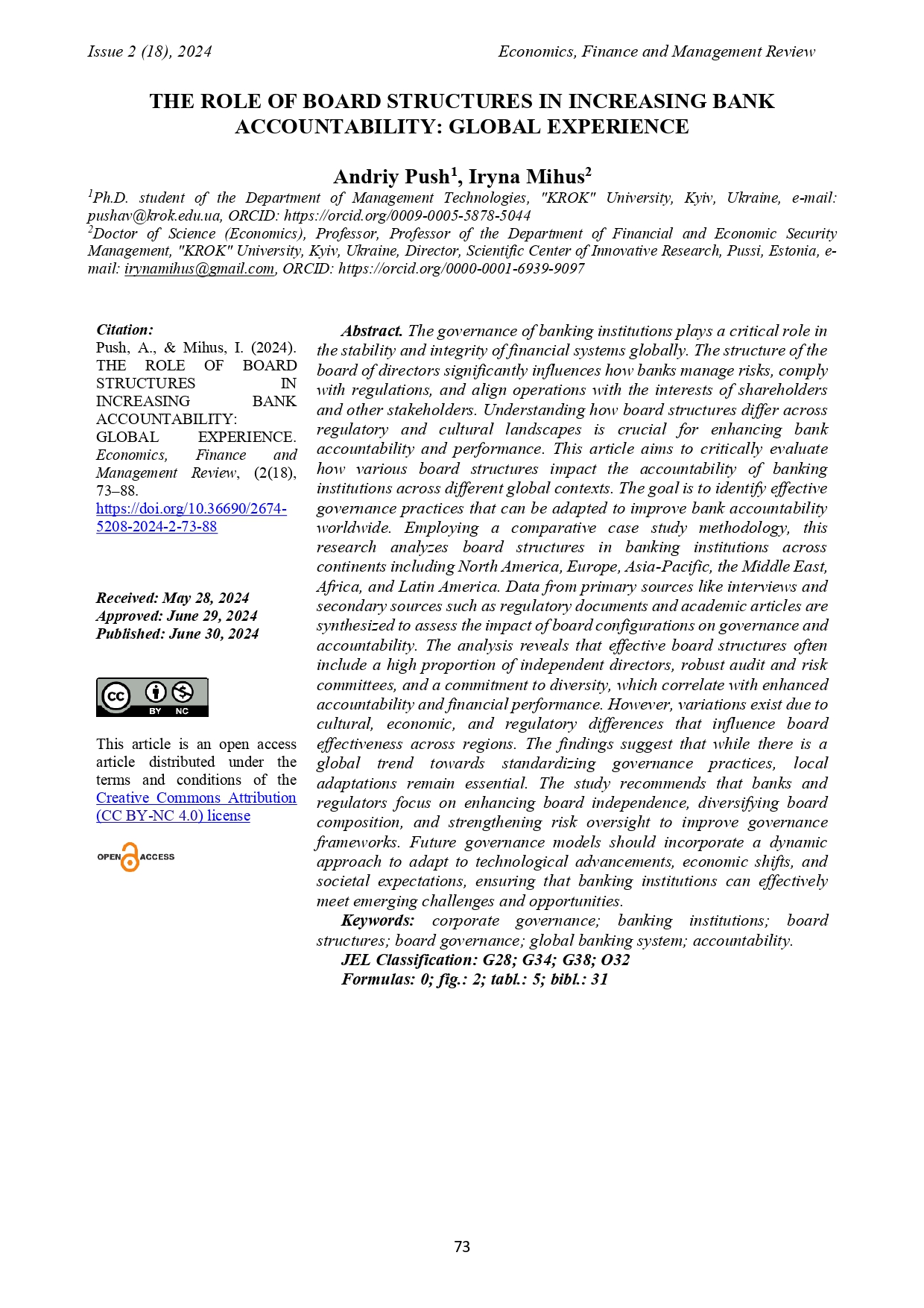THE ROLE OF BOARD STRUCTURES IN INCREASING BANK ACCOUNTABILITY: GLOBAL EXPERIENCE
DOI:
https://doi.org/10.36690/2674-5208-2024-2-73-88Keywords:
corporate governance, banking institutions, board structures, board governance, global banking system, accountabilityAbstract
The governance of banking institutions plays a critical role in the stability and integrity of financial systems globally. The structure of the board of directors significantly influences how banks manage risks, comply with regulations, and align operations with the interests of shareholders and other stakeholders. Understanding how board structures differ across regulatory and cultural landscapes is crucial for enhancing bank accountability and performance. This article aims to critically evaluate how various board structures impact the accountability of banking institutions across different global contexts. The goal is to identify effective governance practices that can be adapted to improve bank accountability worldwide. Employing a comparative case study methodology, this research analyzes board structures in banking institutions across continents including North America, Europe, Asia-Pacific, the Middle East, Africa, and Latin America. Data from primary sources like interviews and secondary sources such as regulatory documents and academic articles are synthesized to assess the impact of board configurations on governance and accountability. The analysis reveals that effective board structures often include a high proportion of independent directors, robust audit and risk committees, and a commitment to diversity, which correlate with enhanced accountability and financial performance. However, variations exist due to cultural, economic, and regulatory differences that influence board effectiveness across regions. The findings suggest that while there is a global trend towards standardizing governance practices, local adaptations remain essential. The study recommends that banks and regulators focus on enhancing board independence, diversifying board composition, and strengthening risk oversight to improve governance frameworks. Future governance models should incorporate a dynamic approach to adapt to technological advancements, economic shifts, and societal expectations, ensuring that banking institutions can effectively meet emerging challenges and opportunities.
Downloads
References
Adams, R.B., and Mehran, H. (2003). "Is Corporate Governance Different for Bank Holding Companies?" Economic Policy Review, 9(1), 123-142.
Aguilera, R.V., and Jackson, G. (2003). "The Cross-National Diversity of Corporate Governance: Dimensions and Determinants." Academy of Management Review, 28(3), 447-465.
Australian Securities Exchange (ASX). (2014). "Corporate Governance Principles and Recommendations."
Basel Committee on Banking Supervision. (2010). "Principles for enhancing corporate governance." Bank for International Settlements.
Bebchuk, L.A., and Weisbach, M.S. (2010). "The State of Corporate Governance Research." The Review of Financial Studies, 23(3), 939-961.
Carter, D.A., Simkins, B.J., and Simpson, W.G. (2003). "Corporate Governance, Board Diversity, and Firm Value." The Financial Review, 38(1), 33-53.
Corporate Governance Code for Banks in Nigeria (2014). Central Bank of Nigeria.
Dodd-Frank Wall Street Reform and Consumer Protection Act of 2010. Public Law 111-203 [H.R. 4173]. Washington, D.C.: U.S. Government Printing Office.
Dubai International Financial Centre. (2018). "Corporate Governance Code."
Erkens, D.H., Hung, M., and Matos, P. (2012). "Corporate Governance in the 2007–2008 Financial Crisis: Evidence from Financial Institutions Worldwide." Journal of Corporate Finance, 18(2), 389-411.
European Banking Authority. (2014). "Guidelines on Internal Governance (GL 44)."
Fama, E.F., and Jensen, M.C. (1983). "Separation of ownership and control." Journal of Law and Economics, 26(2), 301-325.
Hermalin, B.E., and Weisbach, M.S. (2003). "Boards of Directors as an Endogenously Determined Institution: A Survey of the Economic Literature." Economic Policy Review, 9(1), 7-26.
Hermalin, B.E., and Weisbach, M.S. (2012). "Information Disclosure and Corporate Governance." The Journal of Finance, 67(1), 195-234.
Jensen, M.C., and Meckling, W.H. (1976). "Theory of the firm: Managerial behavior, agency costs and ownership structure." Journal of Financial Economics, 3(4), 305-360.
King IV Report on Corporate Governance for South Africa (2016). Institute of Directors in Southern Africa.
La Porta, R., Lopez-de-Silanes, F., and Shleifer, A. (1999). "Corporate ownership around the world." Journal of Finance, 54(2), 471-517.
Macey, J. and O'Hara, M. (2003). "The Corporate Governance of Banks." Federal Reserve Bank of New York Economic Policy Review, 9(1), 91-107.
Mihus, I., & Gupta, S. G. (2023). The main trends of the development of the digital economy in the EU countries. The development of innovations and financial technology in the digital economy: monograph. Editor-in-Chief. M. Denysenko. Scientific Center of Innovative Researches OU, 23-41.
Monetary Authority of Singapore. (2012). "Guidelines on Corporate Governance for Banks, Financial Holding Companies and Direct Insurers."
OECD. (2015). "G20/OECD Principles of Corporate Governance." OECD Publishing.
Reserve Bank of India. (2014). "Guidelines on Governance Issues and Ownership in Private Sector Banks."
Sarbanes-Oxley Act of 2002. Public Law 107-204 [H.R. 3763]. Washington, D.C.: U.S. Government Printing Office.
Saudi Vision 2030. (2016). "Saudi Vision 2030."
Shleifer, A., and Vishny, R.W. (1997). "A Survey of Corporate Governance." The Journal of Finance, 52(2), 737-783.
Tarullo, D.K. (2014). "Regulating the Shadow Banking System." Brookings Papers on Economic Activity, Fall, 261-312.
The Capital Requirements Directive IV (2013). European Union Legislation.
The Markets in Financial Instruments Directive II (2014). European Union Legislation.
Walker, D. (2009). "A review of corporate governance in UK banks and other financial industry entities." Final recommendations, London.
Weisbach, M.S. (1988). "Outside Directors and CEO Turnover." Journal of Financial Economics, 20, 431-460.
Yermack, D. (1996). "Higher market valuation of companies with a small board of directors." Journal of Financial Economics, 40(2), 185-211.

Downloads
Published
How to Cite
Issue
Section
License

This work is licensed under a Creative Commons Attribution-NonCommercial 4.0 International License.








